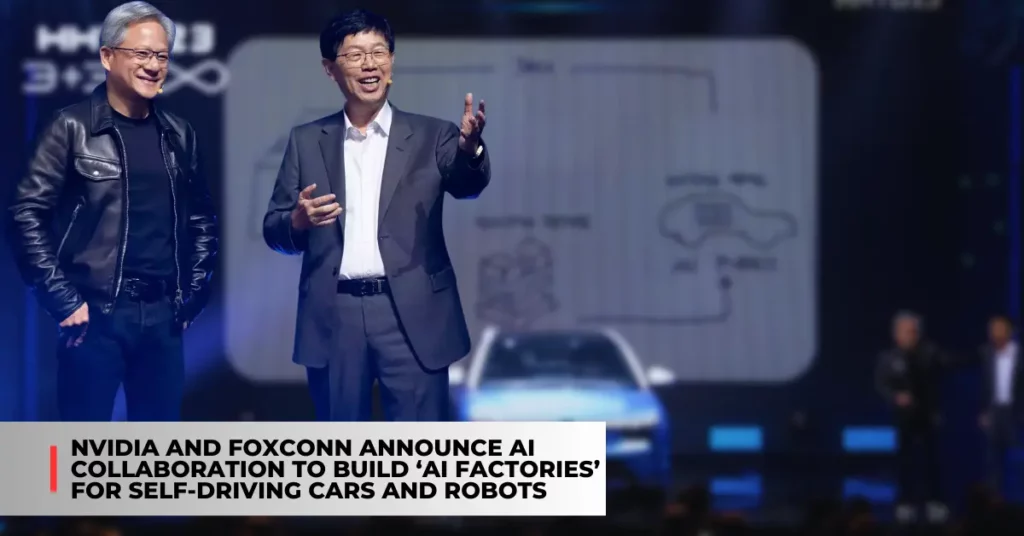Nvidia, the leading graphics and AI chipmaker, and Foxconn, the world’s largest electronics manufacturer, have announced a strategic partnership to build ‘AI factories’ that will offer supercomputing power for developing self-driving cars, autonomous machines, and industrial robots.
Contents
What Are AI Factories?
AI factories are a new class of data centres that are specially built for processing, refining, and transforming vast amounts of data into valuable AI models and tokens.
These models and tokens can be used to power various applications, such as the digitalization of manufacturing and inspection workflows, the development of AI-powered electric vehicles and robotics platforms, and a growing number of language-based generative AI services.
AI factories are based on Nvidia’s GPU computing infrastructure, which includes the latest Nvidia GH200 Grace Hopper Superchip and Nvidia AI Enterprise software.
The GH200 Superchip is a next-generation chip that delivers up to 10 times the performance of the current generation of GPUs for AI workloads. The Nvidia AI Enterprise software is a suite of optimized AI frameworks and applications that run on certified servers powered by Nvidia GPUs.
“We are delighted to expand our decade-long partnership with Foxconn to accelerate the AI industrial revolution,”
“We are delighted to expand our decade-long partnership with Foxconn to accelerate the AI industrial revolution,” said Jensen Huang, the CEO of Nvidia, which is enhancing its collaboration in AI with iPhone assembler Foxconn.https://t.co/hKiKSSAP5X
— Nikkei Asia (@NikkeiAsia) October 18, 2023
How Will Nvidia and Foxconn Collaborate?
Nvidia and Foxconn will collaborate in two ways: first, by creating AI factories together; and second, by developing smart solution platforms based on Nvidia technologies.
Foxconn will integrate Nvidia technology to create AI factories for its global customer base, which is looking to create and operate its own AI factories.
Foxconn will also use Nvidia’s HGX reference designs, OVX reference designs, and networking products to build custom systems based on Nvidia CPUs, GPUs, and networking for its customers.
Foxconn will also develop its smart solution platforms based on Nvidia technologies. These include:
- Foxconn Smart EV: an electric vehicle platform that will be built on Nvidia DRIVE Hyperion 9, a next-generation platform for autonomous automotive fleets, powered by Nvidia DRIVE Thor, its future automotive systems-on-a-chip.
- Foxconn Smart Manufacturing: a robotic system platform that will be built on the Nvidia Isaac autonomous mobile robot platform.
- Foxconn Smart City: a smart city platform that will incorporate the Nvidia Metropolis intelligent video analytics platform.
Check out some other new content we’ve published:
- Microsoft Launches Bug Bounty Program for Bing AI Services
- AI Algorithms for Detecting and Preventing Cyberattacks on Robots
What Are the Benefits of the Collaboration?
The collaboration between Nvidia and Foxconn aims to accelerate the AI industrial revolution, which is the transformation of industries and society by AI technologies.
By building AI factories and smart solution platforms, Nvidia and Foxconn hope to enable their customers to leverage the power of AI to improve their products, services, and operations.
Some of the benefits of the collaboration are:
- Faster development of self-driving cars: By using Nvidia’s DRIVE Hyperion 9 platform, Foxconn can offer its customers a complete hardware and software solution for developing self-driving cars that can handle complex driving scenarios.
- More efficient manufacturing and inspection: By using Nvidia’s Isaac platform, Foxconn can offer its customers a robotic system that can perform tasks such as picking, packing, sorting, inspecting, and assembling in various environments.
- Safer and smarter cities: By using Nvidia’s Metropolis platform, Foxconn can offer its customers a video analytics system that can perform tasks such as traffic management, public safety, retail analytics, and smart parking.
What Are the Challenges of the Collaboration?
The collaboration between Nvidia and Foxconn also faces some challenges. Some of these are:
- Competition from other players: Nvidia and Foxconn are not the only ones who are building AI factories and smart solution platforms. Other players such as Tesla, Google, Amazon, Microsoft, Intel, Alibaba, Huawei, Baidu, Tencent, and others are also investing heavily in AI technologies and infrastructure.
- Regulatory and ethical issues: The development and deployment of AI technologies such as self-driving cars and robots may raise some regulatory and ethical issues. For example, who is responsible for the safety and liability of self-driving cars? How can privacy and security be ensured in video analytics? How can bias and fairness be addressed in AI models? These issues may require careful consideration and collaboration among various stakeholders.
- Technical challenges: The creation of AI factories and smart solution platforms may also pose some technical challenges. For example, how can data quality and consistency be ensured in AI factories? How can scalability and reliability be achieved in smart solution platforms? How can interoperability and compatibility be maintained among different systems? These challenges may require continuous innovation and improvement from both Nvidia and Foxconn.

